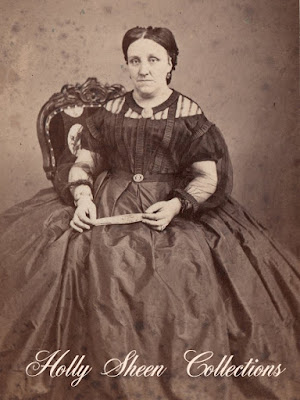Documentation for the usage of hand fans goes back centuries in time. Used by both men and women, the idea of a fan was an old tradition by the mid-1800s. Fans were a practical accessory as well as a pretty bit of frou frou. Air conditioning was not invented until 1902, so you can understand the need for a fan of some type.
The necessity for fans did not change through the centuries, but the sizes, styles, and materials did change.
Before further elaborating on styles, it will be helpful to note the parts of a fan with this diagram. (Courtesy of the Fan Association of North America (FANA))
In the 1860s there were different styles that were in use:
Folding
As the name implies, made of fabric or paper attached to sticks, this fan neatly folds closed on itself and opens into a semi-circle. During this era, these fans range from 8” to 11”, although 9” to 10.5” are the more commons sizes. The sticks and guards can be made of a variety of materials such as wood, bone, ivory, Mother-of-Pearl, tortoise shell, etc. The Leaf portion can also be made of a variety of materials as noted in the above diagram.
Brise
This fan also folds, but the sticks are of rigid material and are joined in place with a ribbon. The sticks themselves may be decoratively pierced or merely painted. This style varies in size.
Jenny Lind or Palmette
Another folding fan with individual silk leaves or palmettes attached to each stick and sewn together with a thread.
Cockade
A folding fan that opens out into a complete circle. When the fan is opened, the guards come round and are latched together to become the handle.
Fixed
A non-folding, rigid fan that is fixed on a stick. This type of fan can consist of various shapes, sizes, and materials, and is thought to be the oldest style of fan.
The industrial revolution brought about the concept of mass production and this affected fans as well. In 1859 Alphonse Baude perfected the machine manufacture of fan sticks. This reduced fans from expensive individual art objects to simply mass-produced products. However, this also made fans more affordable to the general public. Still a popular accessory in the 1860s, now nearly every lady could afford a fan of some type.
 |
| At the Theatre, by James Hayllar |
 |
| Olga Charlotte Marie Gräfin zu Solms-Tecklenburg, by Eduard Robert Bary |
 |
| Portrait of a Lady With a Fan, by Franz Xaver Winterhalter |
 |
| Princess Victoria, by Franz Xaver Winterhalter |
 |
| Portrait of Mrs Augusta Magniac, by Lord Frederic Leighton |
|
|
These are some CDVs from my collection showing everyday ladies carrying fans. You can view more of my collection of fan-carrying women on
this page on my website.

















No comments:
Post a Comment